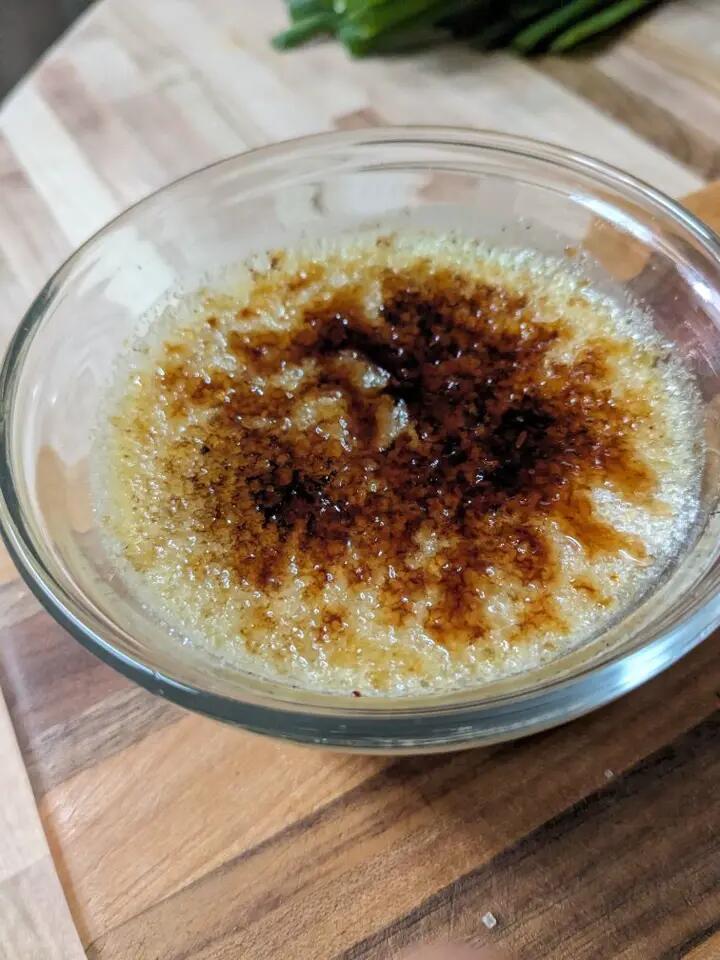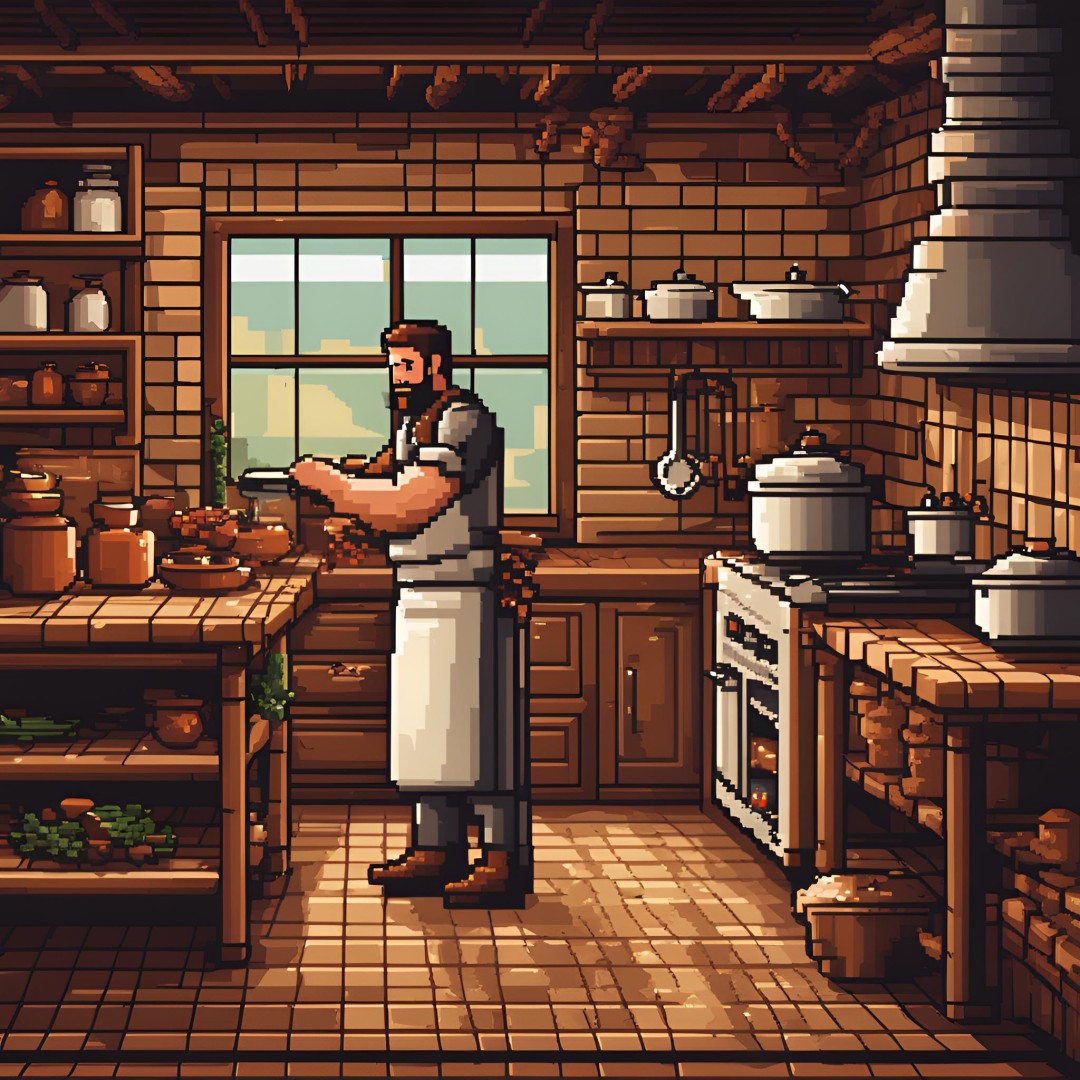Crème Brûlée

Chef's notes
Recommend kosher salt for this recipe as it has a better flavor with the cream.
If you have foam, either skim the top or you can use a torch to get a glass smooth finish on the top.
Details
- ⏲️ Prep time: 30 min
- 🍳 Cook time: 40 min
- 🍽️ Servings: 6
Ingredients
- 2 cups heavy cream
- 10 tablespoons sugar, divided
- 1 vanilla bean (or 1 teaspoon vanilla extract)
- 4 large egg yolks
- 1/2 teaspoon vanilla extract
- 1/4 teaspoon kosher salt
- For the Brûlée topping:
- 4 tablespoons sugar (2 teaspoons per ramekin)
Directions
- Preheat oven to 325°F with a rack in the middle position: Arrange six 4-ounce ramekins in a 9x13 baking dish and set aside.
- Prepare the vanilla bean: Split the vanilla bean in half and scrape out the seeds with the dull (non-cutting) side of a paring knife.
- Warm the cream: In a medium saucepan, combine heavy cream, 4 tablespoons of the sugar, vanilla bean pod, vanilla bean seeds, and salt. Cook over medium heat, until it begins to simmer.
- Infuse the cream: Once the cream begins to simmer, remove the pan from heat, cover, and let stand for 15 minutes to allow the vanilla bean to infuse into the cream. (If you’re replacing the vanilla bean with vanilla extract, skip this step.)
- Separate the eggs and whisk with sugar: When your cream is almost done infusing, separate your eggs. Place the yolks in a medium-sized mixing bowl; save the whites for another purpose. Whisk the remaining 6 tablespoons of sugar into the yolks. (Don't combine the eggs and sugar too soon before you mix it with the warm cream because the sugar binds with the water in egg yolks, which constricts the proteins in yolks and creates eggy lumps. And you don't want eggy lumps in your custard!)
- Temper the yolks and mix with the cream: While whisking the yolks continuously, slowly add one ladle (about 1/4 or 1/3 cup) of hot cream in a thin stream. Do this two or three more times. While whisking, slowly add the remaining cream to the egg mixture, followed by the vanilla extract. Strain the mixture through a fine mesh sieve into a second mixing bowl and discard the vanilla bean pod (this also helps strain out any small bits of egg that may have curdled).
- At this point, the custard can be cooled and stored for up to 5 days. If you choose to bake them right from the fridge, you will probably need to add a couple of extra minutes.
- Fill the ramekins: Divide the custard between the ramekins, filling each one just up to the inner rim, or about three-quarters of the way full.
- Fill the hot water bath: Bring a kettle or pot of water to a boil. Fill the pan with the hot water until the water comes about two-thirds of the way up the side of the ramekins. Avoid splashing water into the custards.
- Bake the custards: Transfer the pan with the custards to the oven and bake for 38 to 40 minutes. When ready, the crème brûlée should have a uniform jiggle in the middle; when you touch the center, it should spring back just a bit. If the sides hold firm but the center sloshes, they aren’t quite done yet. If they are set like Jell-O, they’ve overbaked, although they will still be delicious! Chill them, brûlée them, eat them, love them and celebrate your efforts. If they have overbaked to the point that they look risen in the center, toss them, start again
- Cool and chill the custards: Remove the baking dish with the finished custards from the oven and set on a wire cooling rack. Let the custards cool in the water until you can safely pick up the ramekins by the rim with your fingers. This should take about 15 minutes, depending on how tender your fingers are. (Mine are like asbestos, so I tend to go in rather quickly.) Once removed from the water bath, let each custard rest on the cooling rack for about 15 more minutes. Use a spoon to skim any bubbles off the top, then cover each ramekin with plastic wrap and store in the fridge. Chill for at least 4 hours, or up to 4 days, before serving.
- Brûlée the custards: When ready to serve, remove the custards from fridge. Sprinkle the surface of each custard evenly with about 1 teaspoon of granulated sugar. Rotate the custard as you sprinkle to make sure the sugar evenly coats the surface. Ignite your torch. Hold the flame about 4 inches from the surface of the sugar. Using a circular motion, move the flame across the surface. The sugar will at first begin to bead up, and then will eventually solidify into a hard sugar crust. You want to make sure all the sugar granules have melted, and the sugar has at least a tint of caramel color. The longer you torch the surface, the darker it will become and the more bitter the sugar crust will be. Sprinkle each of the custards with an additional teaspoon of sugar and brûlée the surface again.
